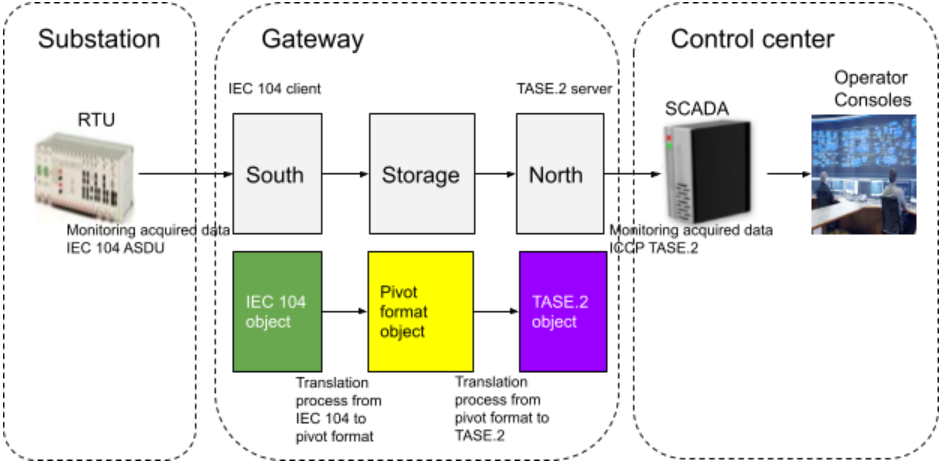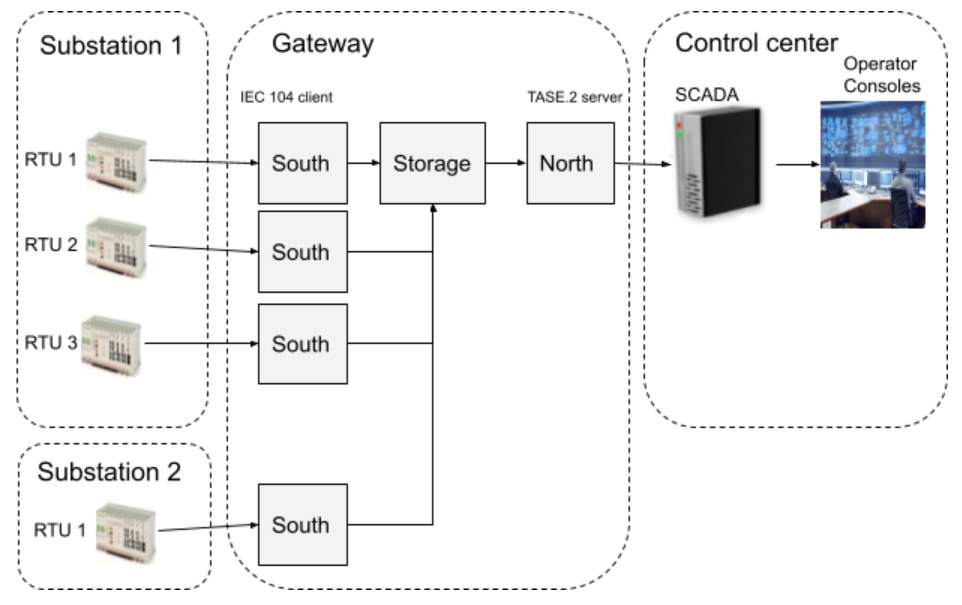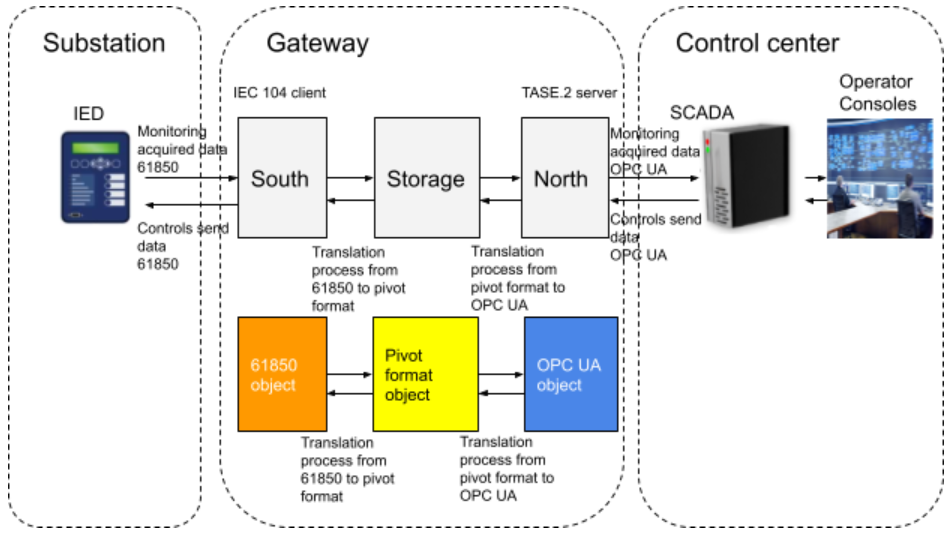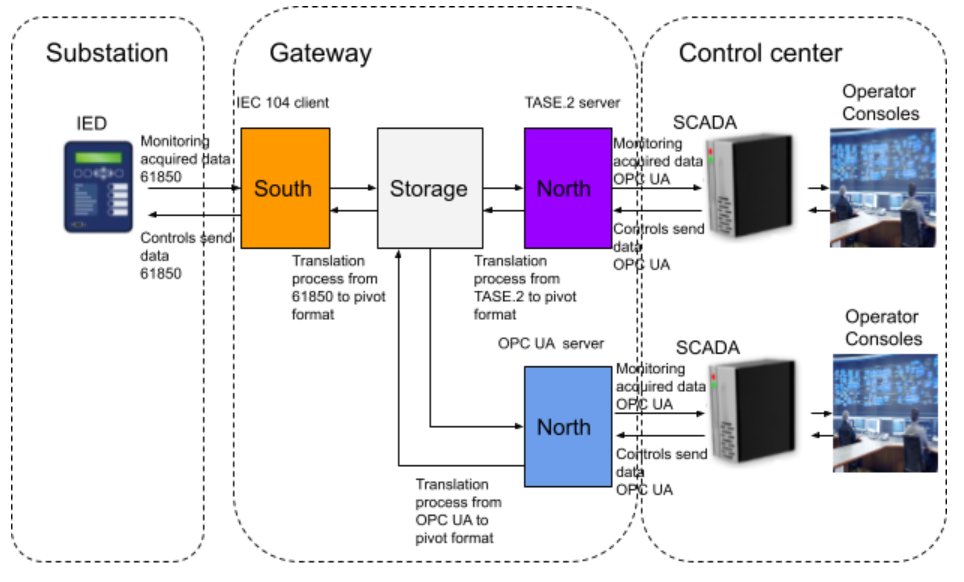Introduction
Being able to configure the way a protocol plugin will manage the communication with the remote servers or clients using the protocol stack parameters, whether communication is secured or not, how the messages attributes are translated from the input protocol data model to the output protocol data model and what kind of rules (filters, math, routing, etc..) to apply to the messages that are exchanges with the remote systems are key features of any protocol translation gateway.
In this design document we will be describing the implementation of the 3 main plugins configuration data models: protocol stack configuration (including application layer, transport layer and security layer), protocols translation configuration, exchanged datapoints configuration and data processing/filtering rules.
FledgePOWER being built on top of Fledge, all the configuration will be described using JSON data structures using nested objects and will be sent to the gateway using the provided HTTP API.
Overview
Functional architecture
Configuration data categories
Protocol translation
Pivot object definition
Before diving into the details of the specification, it is useful to illustrate some use cases. They should help demonstrate how the specification is expected to be used and to help understand the benefits of a pivot object.
The objective of a gateway is to allow communication between different systems by providing some translation mechanisms from one means of communication to another one.
All translation mechanisms introduce a limitation of functionality in the translated space compared to the original space. The major challenge is to provide some correspondences between the two systems, with a limited impact to the original scope of features.
Use case 1: monitoring
Single Substation/RTU gateway
In this use case, monitoring data are acquired from a field device called RTU (Remote Terminal Unit) which acts as a IEC 104 server (slave) and are exposed to the central SCADA which acts as a ICCP TASE.2 client. Each incoming message from the RTU comes as an IEC 104 ASDU object. The south service plugin applies a first translation process which consists of (1) reading and checking the ASDU object using the IEC 104 data model and (2) mapping each data attribute to the corresponding pivot object data attribute. Once the message is converted to a pivot object, it can then be stored or consumed by the north or any other service. The north service plugin can then apply a second translation process which consists of (3) reading and checking the pivot object using the pivot data model and (4) mapping each data attribute to the corresponding TASE.2 data attribute. The resulting TASE.2 object can then be exposed to the TASE.2 client by the north service plugin.
Multiple Substation/RTU gateway
In this alternative scenario, the gateway is connected to multiple RTUs located in multiple substations. Each South plugin (IEC 104 client) is connected to an RTU (IEC 104 server) to collect data. The collected data flow then through the Storage and the North plugin (TASE.2) to expose data to the SCADA.
Use case 2: monitoring and control
Single Scada/single protocol
In this use case data flows in two directions: monitoring and control.
Monitoring data are acquired from a field device called IED (Intelligent Electronic Device) which acts as a 61850 MMS server and are exposed to the central SCADA which acts as a OPC UA client. Each incoming message from the IED comes as a 61850 MMS object. The south service plugin applies a first translation process which consists of (1) reading and checking the 61850 MMS object using the 61850 MMS data model and (2) mapping each data attribute to the corresponding pivot object data attribute. Once the message is converted to a pivot object, it can then be stored or consumed by the north or any other service. The north service plugin can then apply a second translation process which consists of (3) reading and checking the pivot object using the pivot object data model and (4) mapping each data attribute to the corresponding OPC UA data attribute. The resulting OPC UA object can then be exposed to the OPC UA client by the north service plugin.
Control data are received from the control center SCADA which acts as a OPC UA client and are sent to the IED which acts as a 61850 server. Each incoming message from the control center SCADA comes as an OPC UA object. The north service plugin applies a first translation process which consists of (1) reading and checking the OPC UA object using the OPC UA data model and (2) mapping each data attribute to the corresponding pivot object data attribute. Once the message is converted to a pivot object, it can then be stored or consumed by the south or any other service. The south service plugin can then apply a second translation process which consists of (3) reading and checking the pivot object using the pivot object data model and (4) mapping each data attribute to the corresponding 61850 MMS data attribute. The resulting 61850 MMS object can then be exposed to the 61850 client by the south service plugin.
Multiple Scadas/multiple protocols
In this alternative scenario, the gateway is connected to multiple SCADAs using two different protocols. The North plugin (TASE.2) exposes data to the TASE.2 SCADA and the North plugin OPC UA exposes data to the OPC UA SCADA. Instead of having a one to one translation process (61850 to TASE.2, 61850 to OPC UA, TASE.2 to 61850, OPC UA to 61850), we use the pivot object to transmit data from 61850 to both TASE.2 and OPC UA. The translation process is done only once for each protocol.
Benefits and challenges of a pivot object
Benefits
The main benefit of the pivot object is it allows decoupling the protocols data model from each other. Each south or north plugin deals with the complexity and the specifics of a given protocol without interfering with the core of the gateway or with another south/north plugin. Adding new protocol plugins or maintaining existing ones is then made much easier. This contributes in maintaining the whole gateway system at a low level of complexity thus minimizing the costs of new developments or maintenance.
Challenges
In order to reach the goal of simplicity we want to achieve, the main challenge is to be able to build a pivot object that is technically independent from the protocols. The data model should also be neutral regarding protocols data models. The protocol translation should not imply a loss or degradation of the source information, especially in the case where the input and output protocols are identical.
Global process from data acquisition to data exposition
This is an illustration with IEC 104 as input protocol and IEC 104, TASE.2 and OPC UA as output protocols.
We have defined here 3 data processing pipelines (see Fledge documentation about Data processing for more details.)
IEC 104 to IEC 104 direct translation : (1) => (5)
IEC 104 to TASE.2 protocols conversion : (1) => (2) => (3) => (6)
IEC 104 to OPCUA protocols conversion: (1) => (2) => (4) => (7)
Process steps:
(1) IEC 104 ASDU acquisition using the iec104 south plugin, the output is a Datapoint representing the input message.
(2) From IEC 104 to Pivot conversion using the 104toPivot filter plugin, the output is a Datapoint representing a Pivot object of a specific datatype.
(3) Pivot To Tase2 conversion using the PivotToTase2 filter plugin, the output is a Datapoint representing a TASE.2 object of a specific datatype.
(4) Pivot To Opcua conversion using the PivotToOpcua filter plugin, the output is a Datapoint representing a OPCUA object of a specific datatype.
(5) IEC 104 ASDU exposition using the iec104 north plugin, the output is a IEC 104 ASDU.
(6) TASE.2 exposition using the tase2 north plugin, the output is a TASE.2 indication point.
(7) OPCUA exposition using the opcua north plugin, the output is a OPCUA object.
Pivot object model
The pivot object model is based on 61850 semantic.
PIVOT TM model, representation of a tele measurement
| Attribute | Description | Expected values | Mandatory |
|---|---|---|---|
| PIVOT.GTIM.Beh.stVal | ? | ||
| PIVOT.GTIM.Cause.stVal | Cause of transmission | COT Cause of Transmission - FledgePower - LF Energy | Yes |
| PIVOT.GTIM.ChgValCnt.stVal | ? | ||
| PIVOT.GTIM.ComingFrom | Source protocol name | IEC103, IEC104, TASE.2, OPCUA, 61850, etc... | Yes |
| PIVOT.GTIM.Confirmation.stVal | Indicates positive or negative confirmation of activation | true, false, DEFAULT=false | |
| PIVOT.GTIM.Identifier | Unique identifier of the pivot object | Any non-empty string | Yes |
| PIVOT.GTIM.{CDC} | Common Data Class representing the information object | MVTyp | Yes |
| PIVOT.GTIM.NormalSrc.stVal | ? | ||
| PIVOT.GTIM.NormalVal.stVal | ? | ||
| PIVOT.GTIM.TmOrg.stVal | Timestamp origin, genuine = source otherwise substituted | genuine, substituted, DEFAULT = genuine | Yes |
| PIVOT.GTIM.TmValidity.stVal | Timestamp validity | valid, invalid, DEFAULT = valid | Yes |
Example of a pivot model instance representing a Tele Measurement:
{
"@xmlns:xs": "http://www.w3.org/2001/XMLSchema",
"PIVOT": {
"GTIM": {
"Beh": {
"stVal": "on"
},
"Cause": {
"stVal": 1
},
"ChgValCnt": {
"stVal": 1
},
"ComingFrom": "String",
"Confirmation": {
"stVal": true
},
"Identifier": "String",
"MvTyp": {
"mag": {
"f": 0.1,
"i": 1
},
"q": {
"DetailQuality": {
"badReference": true,
"failure": true,
"inconsistent": true,
"innacurate": true,
"oldData": true,
"oscillatory": true,
"outOfRange": true,
"overflow": true
},
"Source": "process",
"Validity": "good",
"operatorBlocked": true,
"test": true
},
"t": {
"FractionOfSecond": 1,
"SecondSinceEpoch": 1,
"TimeQuality": {
"clockFailure": true,
"clockNotSynchronized": true,
"leapSecondKnown": true,
"timeAccuracy": 1
}
}
},
"NormalSrc": {
"stVal": "TELEMETERED"
},
"NormalVal": {
"stVal": "NORMAL"
},
"Origin": {
"q": {
"DetailQuality": {
"badReference": true,
"failure": true,
"inconsistent": true,
"innacurate": true,
"oldData": true,
"oscillatory": true,
"outOfRange": true,
"overflow": true
},
"Source": "process",
"Validity": "good",
"operatorBlocked": true,
"test": true
},
"stVal": "String",
"t": {
"FractionOfSecond": 1,
"SecondSinceEpoch": 1,
"TimeQuality": {
"clockFailure": true,
"clockNotSynchronized": true,
"leapSecondKnown": true,
"timeAccuracy": 1
}
}
},
"TmOrg": {
"stVal": "genuine"
},
"TmValidity": {
"stVal": "VALID"
}
}
}
}
PIVOT TS model, representation of a tele signal
| Attribute | Description | Expected values | Mandatory |
|---|---|---|---|
| PIVOT.GTIS.Beh.stVal | ? | ||
| PIVOT.GTIS.Cause.stVal | Cause of transmission | COT Cause of Transmission - FledgePower - LF Energy | Yes |
| PIVOT.GTIS.ChgValCnt.stVal | ? | ||
| PIVOT.GTIS.ComingFrom | Source protocol name | IEC103, IEC104, TASE.2, OPCUA, 61850, etc... | Yes |
| PIVOT.GTIS.Confirmation.stVal | Indicates positive or negative confirmation of activation | true, false, DEFAULT=false | |
| PIVOT.GTIS.Identifier | Unique identifier of the pivot object | Any non-empty string | Yes |
| PIVOT.GTIS.{CDC} | Common Data Class representing the information object | SPSTyp, DPSTyp, BSCTyp | Yes |
| PIVOT.GTIS.NormalSrc.stVal | ? | ||
| PIVOT.GTIS.NormalVal.stVal | ? | ||
| PIVOT.GTIS.TmOrg.stVal | Timestamp origin, genuine = source otherwise substituted | genuine, substituted, DEFAULT = genuine | Yes |
| PIVOT.GTIS.TmValidity.stVal | Timestamp validity | valid, invalid, DEFAULT = valid | Yes |
Example of a pivot model instance representing a Tele Signal:
{
"@xmlns:xs": "http://www.w3.org/2001/XMLSchema",
"PIVOT": {
"GTIS": {
"Beh": {
"stVal": "on"
},
"Cause": {
"stVal": 1
},
"ChgValCnt": {
"stVal": 1
},
"ComingFrom": "String",
"Confirmation": {
"stVal": true
},
"DpsTyp": {
"q": {
"DetailQuality": {
"badReference": true,
"failure": true,
"inconsistent": true,
"innacurate": true,
"oldData": true,
"oscillatory": true,
"outOfRange": true,
"overflow": true
},
"Source": "process",
"Validity": "good",
"operatorBlocked": true,
"test": true
},
"stVal": "intermediate-state",
"t": {
"FractionOfSecond": 1,
"SecondSinceEpoch": 1,
"TimeQuality": {
"clockFailure": true,
"clockNotSynchronized": true,
"leapSecondKnown": true,
"timeAccuracy": 1
}
}
},
"Identifier": "String",
"NormalSrc": {
"stVal": "TELEMETERED"
},
"NormalVal": {
"stVal": "NORMAL"
},
"Origin": {
"q": {
"DetailQuality": {
"badReference": true,
"failure": true,
"inconsistent": true,
"innacurate": true,
"oldData": true,
"oscillatory": true,
"outOfRange": true,
"overflow": true
},
"Source": "process",
"Validity": "good",
"operatorBlocked": true,
"test": true
},
"stVal": "String",
"t": {
"FractionOfSecond": 1,
"SecondSinceEpoch": 1,
"TimeQuality": {
"clockFailure": true,
"clockNotSynchronized": true,
"leapSecondKnown": true,
"timeAccuracy": 1
}
}
},
"SpsTyp": {
"q": {
"DetailQuality": {
"badReference": true,
"failure": true,
"inconsistent": true,
"innacurate": true,
"oldData": true,
"oscillatory": true,
"outOfRange": true,
"overflow": true
},
"Source": "process",
"Validity": "good",
"operatorBlocked": true,
"test": true
},
"stVal": true,
"t": {
"FractionOfSecond": 1,
"SecondSinceEpoch": 1,
"TimeQuality": {
"clockFailure": true,
"clockNotSynchronized": true,
"leapSecondKnown": true,
"timeAccuracy": 1
}
}
},
"TmOrg": {
"stVal": "genuine"
},
"TmValidity": {
"stVal": "VALID"
}
}
}
}
PIVOT TC model, representation of a tele command
| Attribute | Description | Expected values | Mandatory |
|---|---|---|---|
| PIVOT.GTIC.Beh.stVal | defines different behaviours of a control object: - Direct control with normal security: dct-ctl-wns | enum: dct-ctl-wns, dct-ctl-wes, sbo-ctl-wns, sbo-ctl-wes, DEFAULT = dct-ctl-wes | No |
| PIVOT.GTIC.Cause.stVal | Cause of transmission | COT Cause of Transmission - FledgePower - LF Energy | No |
| PIVOT.GTIC.ComingFrom | Source protocol name | IEC103, IEC104, TASE.2, OPCUA, 61850, etc... | Yes |
| PIVOT.GTIC.DevId.name | ? | No | |
| PIVOT.GTIC.{CDC} | Common Data Class representing the information object | SPCTyp, DPCTyp, INCTyp, APCTyp, BSCTyp | Yes |
| PIVOT.GTIC.Identifier | Unique identifier of the pivot object | Any non-empty string | Yes |
| PIVOT.GTIC.Qu.stVal | ? | No | |
| PIVOT.GTIC.ServiceType.stVal | ? | No | |
| PIVOT.GTIC.Tag.stVal | ? | No | |
| PIVOT.GTIC.TagClass | ? | No | |
| PIVOT.GTIC.TaggedReason | ? | No | |
| PIVOT.GTIC.TmOrg | Timestamp origin, genuine = source otherwise substituted | genuine, substituted, DEFAULT = genuine | No |
| PIVOT.GTIC.TmStamp | Timestamp | No |
Example of a pivot model instance representing a Tele Command:
{
"@xmlns:xs": "http://www.w3.org/2001/XMLSchema",
"PIVOT": {
"GTIC": {
"Beh": {
"stVal": "dct-ctl-wes"
},
"Cause": {
"stVal": 1
},
"ComingFrom": "String",
"DevId": {
"name": "String"
},
"DevSt": {
"q": {
"DetailQuality": {
"badReference": true,
"failure": true,
"inconsistent": true,
"innacurate": true,
"oldData": true,
"oscillatory": true,
"outOfRange": true,
"overflow": true
},
"Source": "process",
"Validity": "good",
"operatorBlocked": true,
"test": true
},
"stVal": true,
"t": {
"FractionOfSecond": 1,
"SecondSinceEpoch": 1,
"TimeQuality": {
"clockFailure": true,
"clockNotSynchronized": true,
"leapSecondKnown": true,
"timeAccuracy": 1
}
}
},
"DpcTyp": {
"ctlVal": true,
"q": {
"DetailQuality": {
"badReference": true,
"failure": true,
"inconsistent": true,
"innacurate": true,
"oldData": true,
"oscillatory": true,
"outOfRange": true,
"overflow": true
},
"Source": "process",
"Validity": "good",
"operatorBlocked": true,
"test": true
},
"stVal": "intermediate-state",
"t": {
"FractionOfSecond": 1,
"SecondSinceEpoch": 1,
"TimeQuality": {
"clockFailure": true,
"clockNotSynchronized": true,
"leapSecondKnown": true,
"timeAccuracy": 1
}
}
},
"Identifier": "String",
"Qu": {
"stVal": 1
},
"ServiceType": {
"stVal": "select"
},
"SpcTyp": {
"ctlVal": true,
"q": {
"DetailQuality": {
"badReference": true,
"failure": true,
"inconsistent": true,
"innacurate": true,
"oldData": true,
"oscillatory": true,
"outOfRange": true,
"overflow": true
},
"Source": "process",
"Validity": "good",
"operatorBlocked": true,
"test": true
},
"stVal": true,
"t": {
"FractionOfSecond": 1,
"SecondSinceEpoch": 1,
"TimeQuality": {
"clockFailure": true,
"clockNotSynchronized": true,
"leapSecondKnown": true,
"timeAccuracy": 1
}
}
},
"Tag": {
"stVal": "NO-TAG"
},
"TagClass": {
"q": {
"DetailQuality": {
"badReference": true,
"failure": true,
"inconsistent": true,
"innacurate": true,
"oldData": true,
"oscillatory": true,
"outOfRange": true,
"overflow": true
},
"Source": "process",
"Validity": "good",
"operatorBlocked": true,
"test": true
},
"stVal": true,
"t": {
"FractionOfSecond": 1,
"SecondSinceEpoch": 1,
"TimeQuality": {
"clockFailure": true,
"clockNotSynchronized": true,
"leapSecondKnown": true,
"timeAccuracy": 1
}
}
},
"TaggedReason": "String",
"TmOrg": {
"stVal": "genuine"
},
"TmStamp": {
"q": {
"DetailQuality": {
"badReference": true,
"failure": true,
"inconsistent": true,
"innacurate": true,
"oldData": true,
"oscillatory": true,
"outOfRange": true,
"overflow": true
},
"Source": "process",
"Validity": "good",
"operatorBlocked": true,
"test": true
},
"stVal": {
"FractionOfSecond": 1,
"SecondSinceEpoch": 1,
"TimeQuality": {
"clockFailure": true,
"clockNotSynchronized": true,
"leapSecondKnown": true,
"timeAccuracy": 1
}
},
"t": {
"FractionOfSecond": 1,
"SecondSinceEpoch": 1,
"TimeQuality": {
"clockFailure": true,
"clockNotSynchronized": true,
"leapSecondKnown": true,
"timeAccuracy": 1
}
}
}
}
}
}
Protocol translation process
Exchanged data configuration
In this chapter we will describe the configuration of the exchanged data. This configuration allow to specify a list of supported data objects. The protocol plugin is expected to make some controls against each entry of the configuration to check:
- if protocol message address or reference is known otherwise throw an error message.
- if protocol type of message is known otherwise throw an error message.
- The label attribute shall be used to populate the Fledge's DataPoint Asset Name attribute.
Attributes definition
| Attribute | Description | Expected values | Mandatory |
|---|---|---|---|
| name | this identifies the exchanged data configuration | Yes | |
| version | this is the version number of the configuration | x.y where x represents a major version and y a minor change | Yes |
| datapoints | array of datapoints that needs to be managed by the instance of the gateway | Yes | |
| datapoints.label | label of the datapoint | any non empty string | Yes |
| datapoints.pivot_id | unique identifier of the datapoint, this is used to create a pivot object | any non empty string | Yes |
| datapoints.pivot_type | type of Common Data Class (CDC), this is used to create a pivot object | enum SpsTyp | DpsTyp | MvTyp | SpcTyp | DpcTyp | ... | Yes |
| datapoints.pivot_subtypes | array of additional types of the pivot object | [transient, ...] | No |
| datapoints.tfid | identifies the math function to transform the input value | enum "normal" | "square_root" | "quadratic" | "transparent" | No |
| datapoints.params | array of parameters for the math function | array of float 32 [a, b, c, ...] | No |
| datapoints.deadband | band of input values where the output is zero | array of 2 float 32 [min, max] | No |
| datapoints.protocols | array of protocols that needs to be managed for a datapoint | Yes | |
| datapoints.protocols.name | name of the protocol | enum "iec104" | "iec103" | "tase2" | "hnz" | "61850" | "opcua" | ... | Yes |
| datapoints.protocols.address | address of the datapoint in the given protocol | any non empty string | Yes |
| datapoints.protocols.typeid | type id of the datapoint in the given protocol | any non empty string representing a valid protocol type id | Yes |
| datapoints.protocols.gi_groups | GI request status for north plugins, if "station" then datapoint is send for south plugins, it determines whether a datapoint is expected in the GI response | enum station | 1 | 2 | ... | No |
| datapoints.protocols.alternate_mapping_rule | Alternate mapping rule to convert datapoint from protocol model to pivot or pivot to protocol model, if not specified then default conversion rule is applied | any non empty string representing a function name | No |
| datapoints.operations | array of operations applied to produce a value for the current datapoint out of one or more input datapoints | No | |
| datapoints.operations.operation | type of operation to perform | enum "or" | No |
| datapoints.operations.input | array of Pivot ID of datapoints to use as inputs for the operation | array of Pivot ID strings | No |
Configuration JSON structure
{
"exchanged_data":{
"name":"SAMPLE",
"version":"1.0",
"datapoints":[
{
"label":"TS1",
"pivot_id":"ID114562",
"pivot_type":"SpsTyp",
"pivot_subtypes":[
"transient"
],
"operations":[
{
"operation":"or",
"input":[
"ID114562",
"ID114563"
]
}
],
"protocols":[
{
"name":"iec104",
"address":"45-672",
"typeid":"M_SP_TB_1",
"gi_groups":"station",
"alternate_mapping_rule":"func_name_1"
},
{
"name":"tase2",
"address":"S_114562",
"typeid":"Data_StateQTimeTagExtended"
},
{
"name":"opcua",
"address":"ID114562",
"typeid":"opcua_sps"
},
{
"name":"iec61850",
"address":"simpleIOGenericIO/GGIO1.Ind1",
"typeid":"SPS"
}
]
},
{
"label":"TM1",
"pivot_id":"ID99876",
"pivot_type":"MVTyp",
"tfid":"square_root",
"params":[
2.0,
49.5
],
"deadband":[
-0.02,
0.02
],
"protocols":[
{
"name":"iec104",
"address":"45-984",
"typeid":"M_ME_NA_1"
},
{
"name":"tase2",
"address":"S_114562",
"typeid":"Data_RealQ"
},
{
"name":"opcua",
"address":"ID99876",
"typeid":"opcua_mvf"
},
{
"name":"iec61850",
"address":"simpleIOGenericIO/GGIO1.AnIn1",
"typeid":"MV"
}
]
}
]
}
}
Do not use the name "IEC104Command" as a datapoint name in the exchanged data configuration. Doing so could potentially lead to conflicts when trying to read readings from both the South and Dispatcher components.



